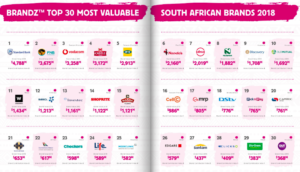Kantar Millward Brown launched the BrandZ™ Top 30 Most Valuable South African Brands on 31 October in Johannesburg and 1 November in Cape Town.
The ranking identifies South Africa’s Top 30 most valuable brands by interviewing over 17,300 South African consumers about their opinions on over 506 brands across 35 categories. BrandZ™ then calculates the dollar value of the intangible brand, enabling businesses to assess how much ‘brand’ drives revenue, growth and market capitalisation.
BrandZ™ is the world’s largest and most definitive brand equity study that combines financial and market data with primary research data from consumers on their views about brands. Commissioned by WPP with valuations by Kantar Millward Brown, BrandZ™ has, over the last 13 years, surveyed more than 3.6 million consumers in 51 countries, creating 5.1 billion data points in the process. It reveals the power of the brand in the mind of the consumer that creates predisposition to buy a brand, and most importantly, validates a positive correlation with better sales performance.
In addition to identifying the strengths and weaknesses of a brand, BrandZ™ helps identify worldwide trends and high potential brands in fast-growth markets. The study is trusted by many of the world’s most established financial institutions, including Citi Research, who publish an annual report on how brands drive equity markets, choosing BrandZ™ to power it. BrandZ™ valuations are also fed directly into the Bloomberg terminals, used by over 300,000 of the world’s most influential decision makers. The Financial Times publishes the BrandZ™ global ranking each year, looking not just at the rankings but at our analysis of why the results are what they are. Brands are becoming increasingly important to CFOs and CEOs, and brand valuation is a metric that quantifies the worth of these powerful but intangible corporate assets.
Charles Foster, CEO Insights Division, Kantar, Africa and Middle East said, ‘A strong brand helps differentiate you from your competitors, is a major source of shareholder value and helps protect your business from risk. It enables brand owners, the investment community and others to evaluate and compare brands and make faster and better-informed decisions. Want proof? In the past 13 years, the S&P 500 has grown in value by 102%, while the BrandZ™ Strong Brands portfolio grew at 172% over the same period.’
‘South African brands show great potential for growth in a region undergoing change. BrandZ demonstrates how brands with strong equity are protected and recover more quickly during tough economic periods, while growing faster during the good times. Those that focus on innovation and building emotional connections with consumers will grow faster,’ added Foster.
The report includes learnings and recommendations from BrandZ™ experts as well as brand building and thought leadership insights from WPP experts in South Africa including Barrows, Burson Cohn & Wolfe, Cerebra, Collective ID, Geometry, Grey, Hill & Knowlton Strategies, Kantar, Mediacom, Ogilvy, Smollan, Student Village, Superunion, The Hardy Boys, TMARC and Wunderman.
The methodology in the BrandZ™ Top 30 Most Valuable South African Brands report mirrors that which was used to calculate the annual BrandZ™ Top 100 Most Valuable Global Brands ranking which is now in its 13th year. The suite of BrandZ™ country rankings and reports also includes China, India, Latin America, Brazil, Saudi Arabia, Spain, the UK, France, Germany, Australia, the U.S. and Italy.
Keynote speakers at the launch included David Roth, CEO of WPP’s the Store & Chairman BAV, who shares an overview of BrandZ and ‘brand’ South Africa, Doreen Wang, the Global Head of BrandZ who shares key learnings form the global study and Nigel Hollis, Chief Global Analyst for Kantar Millward Brown, who talks about how to leverage disruption to win. There will also be a panel discussion with leading South African marketers including Abey Mokgwatsane, Managing Executive of Brand at Vodacom, Charlene Van Zyl, Head of Customer at Woolworths, Doug Place, CMO Nando’s, Tshego Tshukutswane, Director Kantar Consulting, Francois Viviers, Executive: Marketing and Communications at Capitec Bank, Nunu Ntshingila, Head of Facebook Africa, Thulani Sibeko, CMO Standard Bank, and Eric Salama, the Global CEO for Kantar.
David Roth, WPP commented, ‘As South Africa looks towards future growth, local brands have a critical role to play in both the country’s development locally and how the country is viewed on the global stage. Its strengths and diversity are reflected in the ranking as leading brands across a range of categories demonstrate their ability to innovate and make a difference in consumers’ lives.’

Other trends highlighted in the BrandZ™ Top 30 Most Valuable South African Brands report include:
- Meaningful difference predicts long-term brand value – brands need to be meaningful and make a difference to consumers by meeting their functional and emotional needs to create affinity; they need to create difference by being perceived as distinctive, giving them a competitive edge. The most meaningfully different South African brands are Woolworths, Dis-Chem, Nando’s and Clicks. These brands are differentiating themselves by driving strong brand purpose, a unique brand experience and then amplifying this through great market communication. Collectively, the BrandZ Top 30 brands are significantly more meaningfully different than the national average, however South Africa’s Top 30 differentiation metrics rank below average relative to their worldwide counterparts.
- Creativity drives innovation – brands that are perceived as creative by consumers capture interest and grow more than competitors who are perceived as unimaginative and dull. Nando’s clever and controversial advertising campaigns are good examples of how a brand can communicate effectively with its target audience, in a very real and relevant way.
- Technology brands have not yet entered South Africa’s Top 30 – however many of the country’s brands, including those in the more traditional categories like banks, retail and telecom providers, have adopted technological disruption to distinguish themselves from competitors. Examples include First National Bank’s ‘open a bank account with a selfie’ and Capitec’s biometric security. Up-and-coming brands are also using technology to disrupt, with Takealot purchasing Mr Delivery and Showmax partnering with DStv.
KANTAR MILLWARDBROWN www.millwardbrown.com










